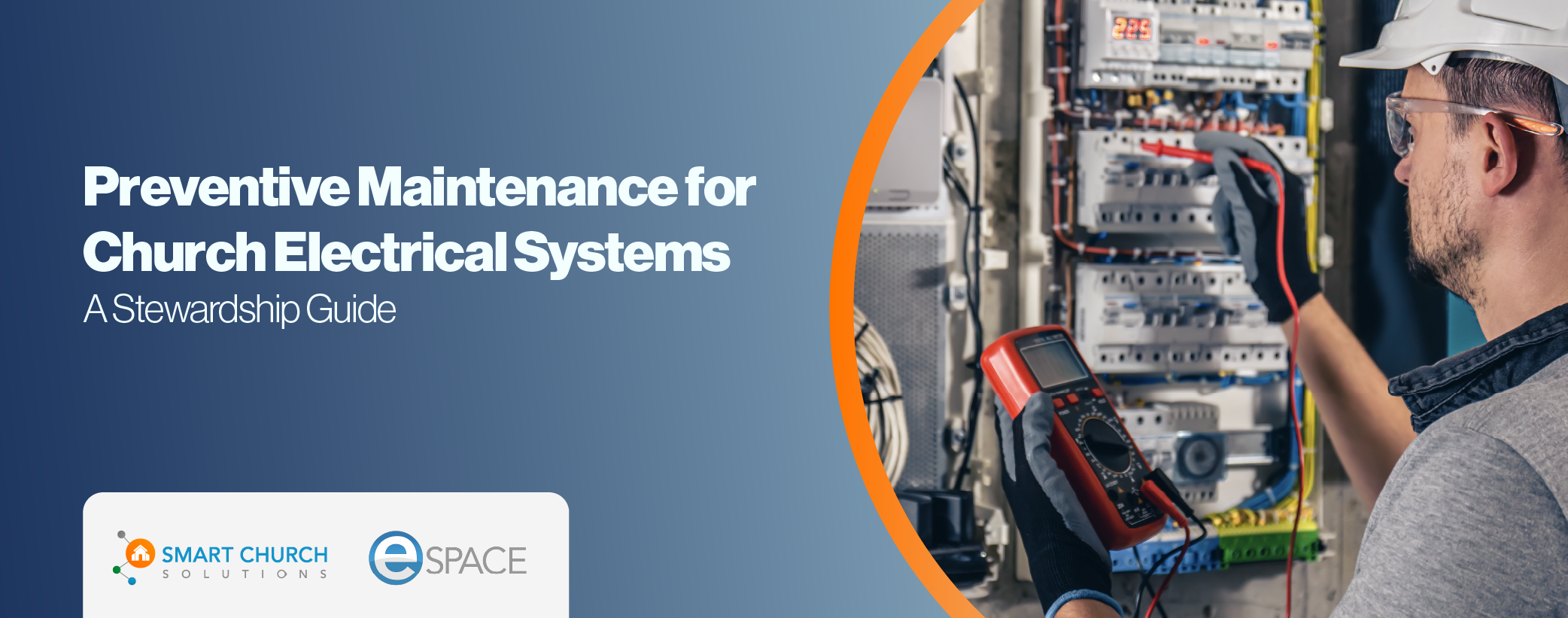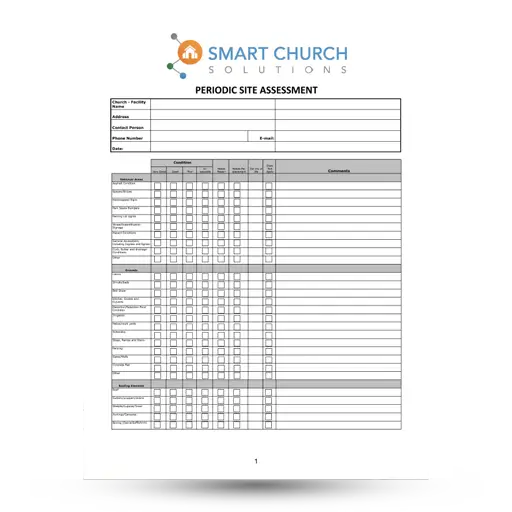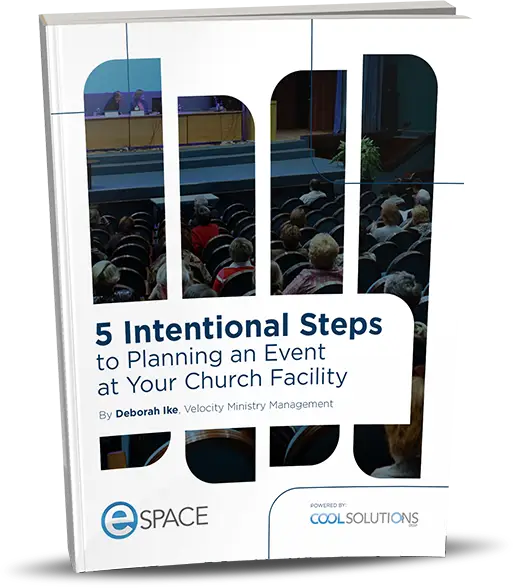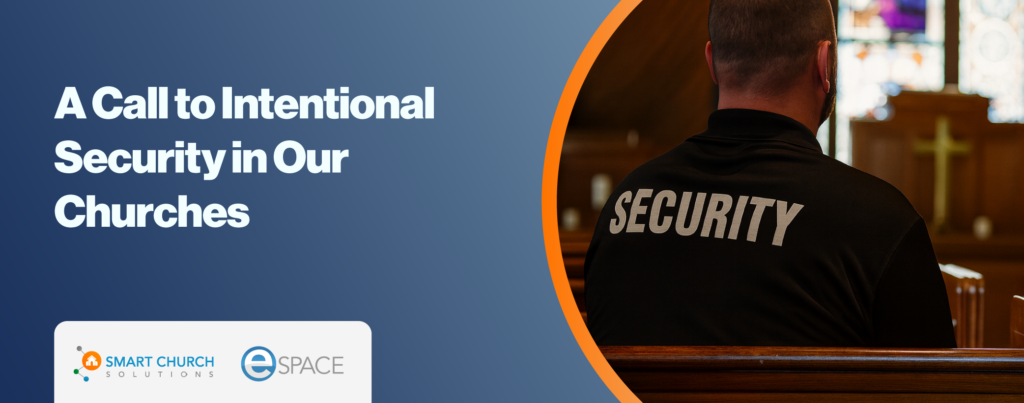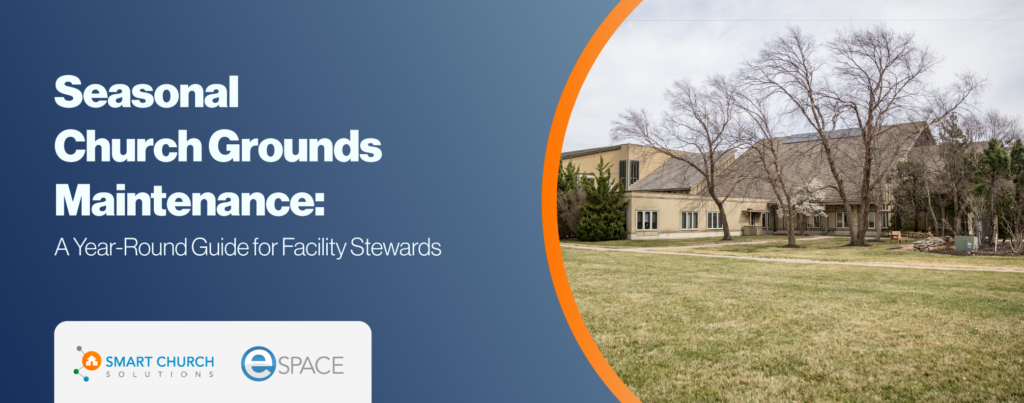When it comes to managing a church facility, electrical systems often go unnoticed, quietly powering services, events, and everyday ministry. That is, until something goes wrong. A flickering light during worship, a tripped breaker in the middle of a community event, or an unexpected outage can quickly disrupt your ministry’s momentum. Worse yet, neglected electrical issues can lead to fire hazards, safety risks, and expensive repairs.
At Smart Church Solutions, we believe that maintaining a church’s electrical system is essential to facility stewardship. Proactive maintenance ensures safety, reliability, and efficiency while preventing costly surprises.
In this guide, we’ll walk through the key preventive maintenance tasks every church should include in its facility management plan.
Why Preventive Electrical Maintenance Matters
Electrical failures don’t happen overnight. Most issues develop slowly over time, caused by aging equipment, daily wear and tear, or overlooked repairs. Without routine maintenance, small problems can quietly turn into major hazards, expensive fixes, or disruptive outages.
Proactive electrical maintenance isn’t just about preventing breakdowns. It’s about protecting your people, preserving your resources, and keeping your ministry moving forward without interruption. When done consistently, preventive maintenance delivers clear, tangible benefits:
- Prevent Safety Hazards – Faulty wiring is one of the leading causes of church fires.
- Reduce Energy Costs – Inefficient electrical systems waste power, increasing operating expenses.
- Extend Equipment Lifespan – Overloaded circuits and poor connections shorten the life of lighting, sound systems, and HVAC equipment.
- Minimize Service Disruptions – Electrical failures can shut down services, events, and essential facility operations.
Key Preventive Maintenance Tasks for Church Electrical Systems
A church’s electrical system works quietly behind the scenes, but it requires regular care to stay safe and reliable. Preventive maintenance helps you catch small issues before they turn into costly problems and ensures your building remains a welcoming, functional place for worship and ministry.
While some tasks should be handled by a licensed electrician, many can be incorporated into your regular facility management routines. Below are the essential preventive maintenance tasks every church should prioritize to protect people, property, and programming:
1. Perform Routine Electrical Inspections
Regular inspections are one of the simplest and most effective ways to catch small electrical issues before they turn into major problems. At least every 6–12 months, have a qualified electrician inspect:
- Breaker panels for loose connections, corrosion, or signs of overheating.
- Wiring conditions in high-use areas (sanctuary, kitchen, offices).
- Light fixtures and outlets for discoloration or burning smells.
- Extension cords and power strips to ensure proper use and avoid overloading.
Electrical inspections help identify potential risks before they lead to failures or fire hazards.
2. Test Emergency Lighting and Exit Signs
In an emergency, reliable lighting can save lives. Be sure your church is prepared for power outages — especially during evening services and events.
- Check emergency exit signs to ensure they are illuminated and batteries are functional.
- Test emergency lighting by simulating a power outage (turning off the main breaker).
- Inspect backup power sources (generators, battery backups) to ensure they operate correctly.
Malfunctioning emergency lighting can put lives at risk in an evacuation scenario.
3. Maintain Breaker Panels and Electrical Subpanels
Breaker panels are the heart of your church’s electrical system, and they require regular attention. Keep them in good working order by:
- Keep panels clean and clear – No storage or debris should block breaker panels.
- Tighten connections – Loose wires can cause overheating and power fluctuations.
- Label circuits properly – Ensure every breaker is labeled for easy troubleshooting.
- Check for tripped breakers – Frequent tripping may indicate an overloaded circuit.
A well-maintained breaker panel ensures efficient power distribution and prevents overloads.
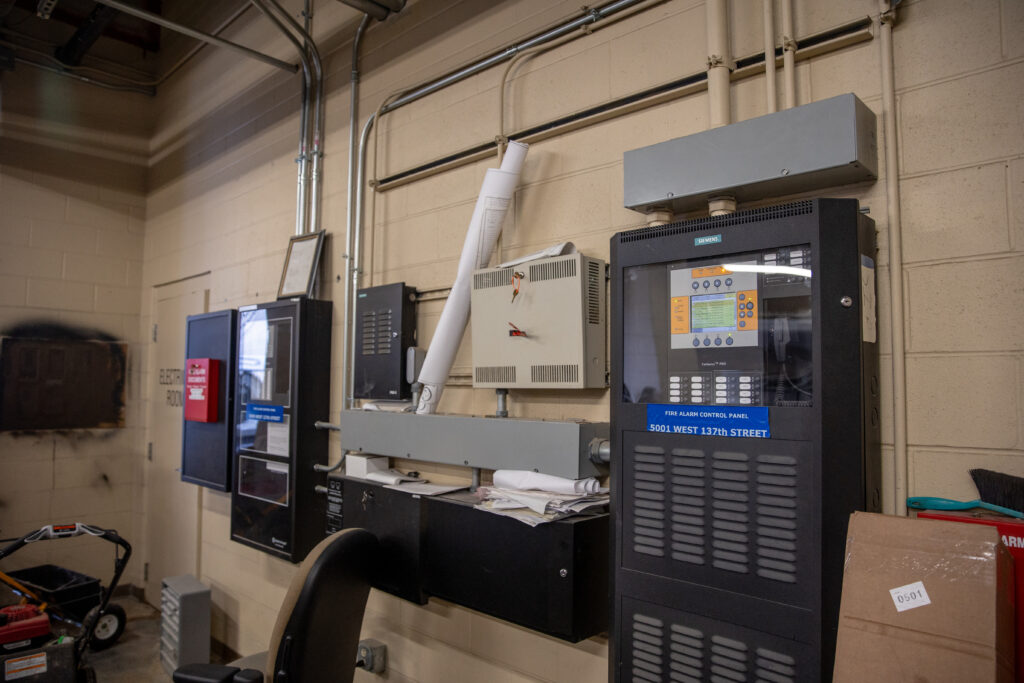
4. Inspect and Maintain Outlets and Switches
Outlets and switches are used daily in churches and can wear out over time.
- Check for loose or damaged outlets – Loose connections can cause arcing, leading to fires.
- Replace cracked or broken outlet covers – Exposed wires pose a safety hazard.
- Test outlets with a circuit tester – Ensure proper grounding and polarity.
- Check GFCI (Ground Fault Circuit Interrupter) outlets – Test them monthly in kitchens, restrooms, and outdoor areas.
Outlets and switches are small components, but they play a big role in electrical safety.
5. Evaluate Lighting Systems
Lighting is a major energy consumer in churches. Keeping it in good condition improves efficiency and reduces costs.
- Inspect for flickering lights – This could indicate a loose connection or failing fixture.
- Replace burnt-out bulbs promptly – Avoid stress on circuits due to unbalanced loads.
- Upgrade to LED lighting – LED bulbs use 75% less energy and last significantly longer.
- Clean light fixtures – Dirt and dust reduce efficiency and brightness.
Well-maintained lighting enhances worship experiences and reduces utility costs.
6. Test Sound and AV Equipment Power Sources
Churches rely on sound systems, projectors, and live-streaming equipment—all of which depend on a stable electrical supply.
- Use surge protectors on all AV equipment to prevent damage from power spikes.
- Check for buzzing sounds or interference – This may indicate wiring issues or grounding problems.
- Ensure outlets in the AV booth are adequate – Overloading power strips can damage equipment.
Protecting AV equipment ensures smooth services and avoids costly repairs.
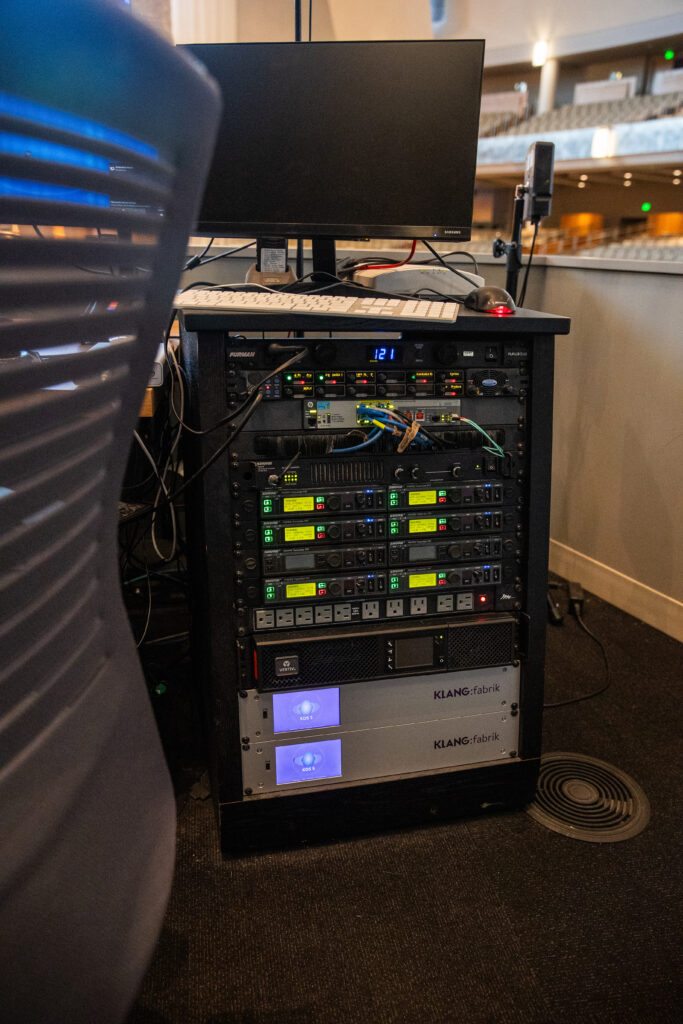
7. Monitor HVAC Electrical Components
Church HVAC systems consume significant electricity, and faulty electrical connections can reduce efficiency or lead to failures.
- Check thermostat connections to ensure accurate temperature readings.
- Inspect wiring and fuses in HVAC control panels.
- Ensure proper airflow around HVAC electrical components to prevent overheating.
- Use energy management tools like eSPACE’s COOLSPACE to optimize HVAC usage and reduce costs.
Regular HVAC electrical maintenance prevents failures during extreme weather conditions.
8. Check for Electrical Code Compliance
Churches, especially older buildings, may have outdated electrical systems that no longer meet current safety codes.
- Ensure all wiring meets modern safety standards (no aluminum wiring, proper grounding).
- Verify that smoke and carbon monoxide detectors are installed and functional.
- Confirm all exterior electrical components are weatherproof and up to code.
Code compliance ensures safety and helps avoid fines or insurance issues.
Recommended Electrical Maintenance Schedule
Using a facility management tool like eSPACE can help track these tasks and set automated reminders.
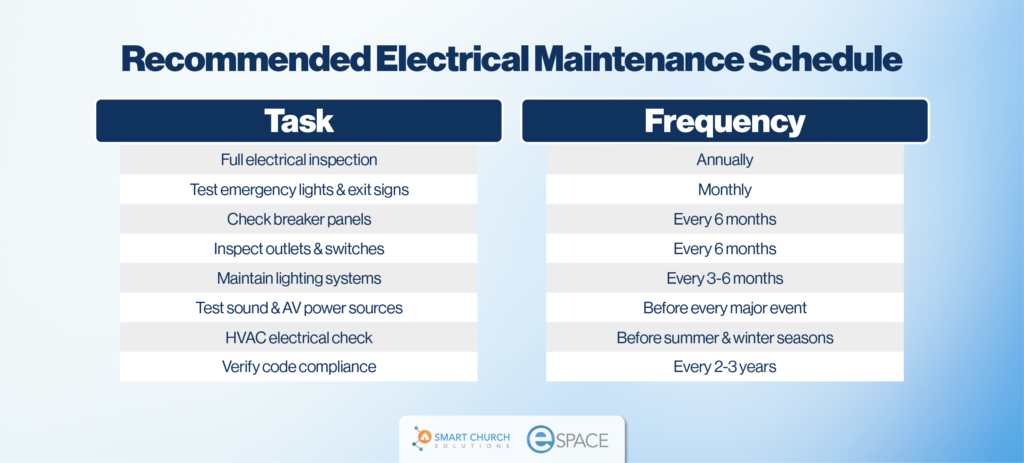
Facility Stewardship is Ministry
At the end of the day, preventive maintenance isn’t just about avoiding electrical failures or saving money, it’s about caring well for what God has entrusted to your church. A reliable, efficient, and safe electrical system keeps your services, ministries, and community events running smoothly. It protects your people, preserves your facility, and honors the resources you’ve been given.
When you proactively maintain your church’s electrical systems, you’re not just managing a building — you’re supporting ministry. At Smart Church Solutions, we’re passionate about helping churches steward their facilities with wisdom and intention. From organizing work orders to tracking inspections and improving energy efficiency, our tools are designed to make facility management easier and more effective.
Need a better way to manage your church’s maintenance plan? Let’s start a conversation. We’d love to help.


